In a Maas shell every detail of design has a purpose. There are no awkward contours, no gimmicky hull shapes.Just the beauty of clean, functional simplicity. We have a passion for creating the best boat for its purpose and for ensuring that the people who row our shells have the boat that is right for them. We encourage potential Maas shell owners to try other boats as well as ours. Row them, inspect the quality of finish inside and out, examine the adjustability of the rigging. Is the shell pleasing to the eye? Can you lift it? We think the better informed you are about rowing shells the more likely you are to row one of ours.
Design
Notice the flared hull shape of our shells. They are substantially wider at the deck than the waterline. Chris began perfecting this shape in 1978. The flare, while subtle, has several advantages:
- The hull form the water “sees” is relatively narrow. This is fast. However, a narrow unflared hull is unstable. Add flare and now as the shell tips, the hull in effect, becomes wider. A quick skinny shell when you are rowing well, but goof up a stroke and presto, stability when you need it.
- The flared hull form helps deflect waves and spray.
- Our shells carry a wide weight range. With the flared hull form, volume increases or decreases rapidly with the shell’s vertical movement. A heavy rower will not cause the shell to ride too low. Conversely, a light rower will not be perched too high. An added benefit is an increase in waterline beam for heavier rowers (who need more stability). A narrower beam for lighter rowers (who need less).
Other design advantages include:
- Minimum wetted surface hull form
- External hull to deck bond; adds strength and stiffness; deflects spray; easier to carry shell and enables storage on edge
- Small volume cockpit; holds less water when it gets really rough.
Over thirty years of shell design experience have given us the insight into what works and what doesn’t. All aspects of our designs balance. Freeboard (height above water), rocker (the curve of the keel fore and aft), section shape and cockpit placement blend as a harmonious whole. When you row a Maas Shell you’ll find that it just feels right.
Construction
Testing new materials, refining proven methods and choosing the most appropriate technology for the job are the basis for building Maas shells. The careful and skillful application of materials; variable thickness and density foam cores for panel stiffness; fiberglass for impact resistance and stiffness; carbon fiber for its high stiffness and strength; resilient vinylester resin and rigid I-beam construction, are the key components of our boats. These light, strong, sophisticated materials can be readily repaired by your local fiberglass repair shop, should the need arise.
Carbon
Maas shells are offered in carbon fiber, an incredibly stiff and strong material. Combined with the impact resistance of fiberglass, a syntactic foam core and vinyl ester resin, the Carbon Series shells are even stronger, stiffer and lighter than our standard boats. Longitudinal rigidity is provided by a Nomex honeycomb/carbon fiber I-beam.
Enhanced performance, increased durability and ease of carrying make a Carbon series shell a very attractive option.
For the ultimate in lightness, the performance package option (carbon fiber seat and foot stretcher, ball bearing wheels and titanium oarlock pins) shaves an additional 1.3 lbs. of weight.
Rigging
Without waxing too rhapsodic about the beauty and functionality of our rigging systems, here are the basics:
You, the sculler, must be able to rig your shell the way that suits you and your rowing style. Our shells are sufficiently adjustable to ensure your enjoyment, freedom from injury and efficiency.
The components should function smoothly stroke after stroke, mile after mile, year after year. With a Maas shell that is what you get.
We are happy to work with your custom requirements for rigging or construction. Please don’t hesitate to contact us with any questions or if you’d just like to talk about rowing.

